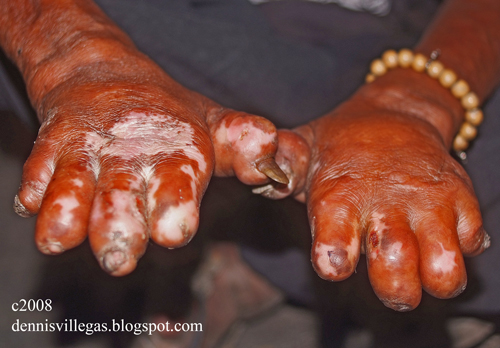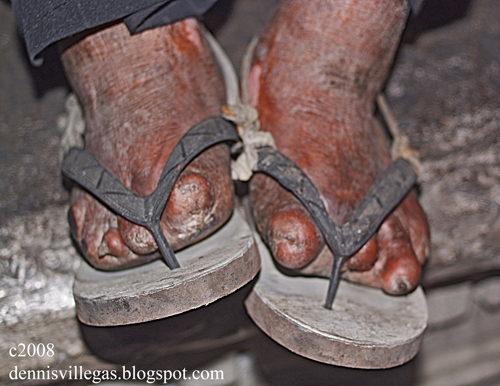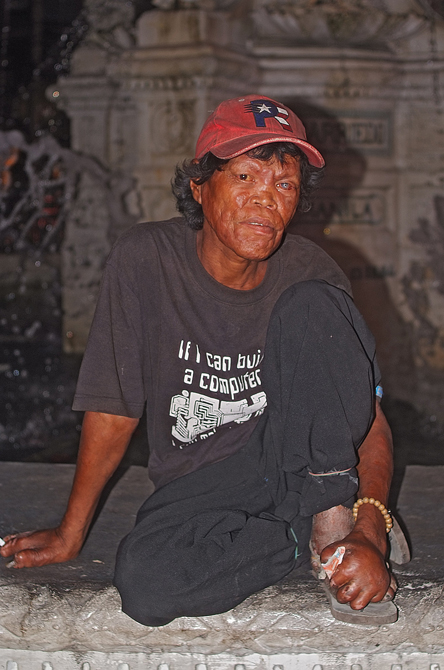During one of my late and lonely walks in the streets of Manila, I noticed a gaunt and hunched figure trying to take refuge in one of the dark sidewalks of Avenida Rizal. Sleepless and listless, he settled into a darkened alley and slumped there. As I walked near him, he held out his hand and begged for a few coins.
He was Mang Lando, 39 years old, one of the paupers who made Plaza Sta. Cruz their permanent home. Six years ago, Mang Lando suffered from a numb sensation in his skin. Shortly afterwards, he developed severe skin lesions. He didn't know what was wrong, until his fingers began to "falloff". The local doctor who first saw his condition, immediately knew what was wrong. All the symptoms are the tell-tale signs of history's most dreaded disease: leprosy.
Mang Lando's family, fearing he may infect them, immediately sent him to Tala Leprosarium* in Caloocan so that he could be quarantined—and maybe treated if there was cure. No one dared accompany him.
But Mang Lando didn’t like Tala—it was an unpleasant place filled with sick and disabled people. It was a government institution, and as usual, ill-funded. In fact, according to Mang Lando, the government stopped supporting the leprosarium, and many patients were no longer receiving their doses of medications. The living quarters stank and so was the food.
Mang Lando escaped from the leprosarium, returned home, but was promptly rejected by his family. He settled in Plaza Sta. Cruz from then on. His condition worsened: he developed severe skin lesions, followed by losing his fingers and toes. His left eye was blinded. He was being rapidly ravaged by the disease. Fortunately, a few generous souls noticed his condition and gave him a regular supply of medications. Thanks to modern science, leprosy can now be cured, although its effects can no longer be reversed. Mang Lando’s skin lesions will be there forever—his fingers and toes will no longer regenerate. His left eye will be blind forever.
Mang Lando loved the darkness the night brings. For then, he could escape the social curse brought about by the disease. Many people didn’t want him near them. Children mock him calling him names “ketongin!” , “ketongin!, lumayo ka sa amin!” (Leper, leper! Get away from us!”) Even fellow paupers refused to be near him, and when he sleeps, he was far from the other street-sleepers of downtown.
But Mang Lando was already cured of the disease. Lepers who received even just a few days’ medication are no longer infectious. The medication also stops the progression of the damaging effects of the disease (such as skin lesions, falling fingers and toes)**
Moreover, ninety-five percent of people are immune to the virus that causes leprosy, and those remaining five percent can now easily be cured even if they were infected. Early detection is essential so that the debilitating effects will not take place. Gone were the days when leprosy was considered the “dreaded” disease. In fact, the World Health Organization has already “numbered” the days of leprosy as a public health hazard.
This was the reason why the Tala Leprosarium already ceased to be given funds by the government. In fact, leprosariums and so-called “leper colonies” were now being closed down because the disease can easily be cured even at home without risking the infection of family members.
Thus the social stigma marked by leprosy is all that has remained to be battled. The government should make an effort to erase this cursed stigma so that unfortunate people like Mang Lando can live and interact with society more freely, and no longer take asylum in the weary darkness of the night.



Mang Lando poses in front of the Carriedo Fountain. Some people sitting there went away quickly when Mang Lando and I sat there.
Related post:
Mang Lando's Only Friend*Founded in 1940, the Tala Lerosarium is Asia's oldest leprosarium. It is now closed, and in its place, a housing project was started by Vice-President Noli de Castro to house the previous patients. NGOs now help to build the community for the former patients.
**If only Mang lando recognized the early symptoms of leprosy, he would not have suffered its debilitating effects




No comments:
Post a Comment